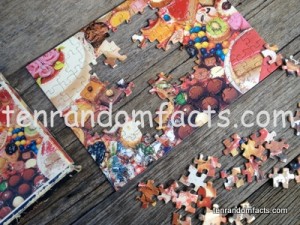Get your brain whirring…
- The jigsaw puzzle concept originated in the 1760s when European map makers glued maps on wood and cut them up into pieces.
- Originally designed for children and educational purposes, jigsaw puzzles for adults didn’t appear until the 1900s.
- Jigsaw puzzles originally weren’t interlocking, and the first interlocking jigsaw puzzle pieces were first produced in 1909.
- Wooden jigsaw puzzles originally were cut individually, piece by piece, until presses and die cuts were used.
- Jigsaw puzzles get there names by the original tool that was used to cut up the puzzle’s pieces, the jigsaw.
- Typically, modern jigsaw puzzles are enlarged versions of photographs or paintings glued onto cardboard.
- Jigsaw puzzles typically are 300, 500,750 or 1000 pieces.
- In 2011, the largest commercial jigsaw puzzle was produced and contained 32,256 pieces and measured 544 cm by 192 cm.
- In the 1990s, the production of foam or wood three dimensional puzzles began, and have become quite popular.
- Doing jigsaw puzzles regularly is said to help prevent Alezheimers, and also benefits the brain in other areas.






And it’s something we do a lot in our family!
Definitely!
I would like to know the name of the company who you stated made the first interlocking jigsaw puzzle and if they were considered “fully interlocking”, meaning they “locked” on all four sides of each piece. I believe I have the answer if you don’t.